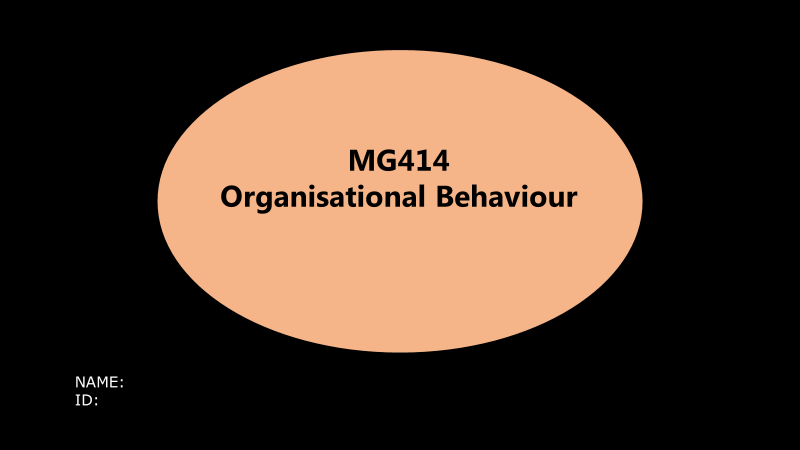Organisational behaviour core concepts and applications
MG414
Organisational Behaviour
1
3
Introduction
Organisation culture can simply be referred to as a code of conduct within the organisational barrier. Every employee working at an organisation has to abide by those regulations. These rules are established after thorough research by executives. Culture in an organisation sets communication methods, chain of command and facilitates information pipeline. These are set to focus on overall organisational performance by manipulating the workforce. Culture or code of conduct differs from organisation to organisation (Mullins, 2014). But some popular methods are used in many companies. Glencore Plc follows their own culture that very much suits their business activities and improves the individual contribution of the workforce too.
There is a popular framework of a culture that is classified into four segments. Roger Harrison and Charles handy introduced this model through researching authorized power and individual cooperating. According to the theory they gave, it is not always a must for culture to prove benevolent for the organisation. Sometimes things can go south. In the light of organisational culture practiced in Glencore, there’s a brief discussion on how the model works.
Fig 1: Handy’s model of organisational culture (Stanford, 2010).
Task culture: This culture is commonly noticed in many organisations that try to aim for a stronghold in a highly competitive market by accomplishing a certain set of goals or projects. This culture is compatible with organisations that follow a matrix structure (Wood et al., 2019). In the organisation, where every sector is divided entirely based on activities like sales, manufacture, marketing; employees from a different department, are selected to play their part in completing a project or task. The significance of this culture is that employees from different departments merge and increases internal communication and enhances teamwork. But it is short term method where the team gets dissolved after achieving the goal.
2. Exploring how culture improves organisational effectiveness with
a focus on communication at Glencore
7
Non-verbal communication impact: Non-verbal communication plays a major role in the communication process of an organisation. As most of the time, the workers do not have proper opportunities to complete a conversation to communicate directly (Wood et al., 2019). The existence of non-verbal communication between management and employees along with each other helps the workstation environment to be much more comfortable and energetic. Behaviours along with body posture facial expression and eye contact are the key in this communication process. Fulfilling such small details helps the company to cheer their employees boost the overall performance.
3. Theories of motivation and the role of culture on employee
motivation
Social needs: As a social being, everyone wants to live in a society with their heads high. People hope to keep a good relationship with others and cherish everyday life and exactly what this stage of needs is all about. Glencore provides extra facilities to its employees on special occasions.
9
Analysing human behaviour and dealing with different personalities is the most challenging part for an HR manager. They need to identify which and what kind of motivational factor will work on whom.
Intrinsic motivational factor: Human nature sometimes tends to work hard willingly for no particular reason. It is not unexpected because a person can perform out of enjoyment or simply he/she can take up a task as a challenge to thyself.
The success of a company in the market depends on multiple aspects that vary from one another. However almost every determined aspect is related to the communication procedure as the failure of this procedure can lead to many chaotic events. Glencore ensured the existence of proper guidelines and communication to keep the workers motivated and up to date with company objectives as per the internal culture requirements (Killaly, 2020). This process has helped the company to increase its performance consistently since its update. The section below shows how the company can use the culture to further enhance organisational success:
Diversity at work: Due to such incredible movement of globalization diversity around us has become a very common issue hence it's only natural to have diversity in the workplace. Not only diversity just offers different types of ideas but also a handy way to communicate with a diverse range of customers (Wilson, 2013). Glencore has appointed its employees from different backgrounds and cultures based on their talent. Despite having troubles at the first stage the company overcame them through their excellent communication and motivational support.
Conclusion
Instead of just following a culture that other organisations have succeeded with, an organisation should evaluate their current positions and determine which kind of changes prove beneficial for them. Glencore tried task and power culture systems which worked pretty well for them. They also put some effort into non-verbal communication in creating an impact and fluent communication within the office premise. They try to give enough consideration to the individual needs of each employee. Glencore Ltd believes in diversification and prioritizes democracy in their culture.
Kotter, J.P. and Heskett, J.L. (2011). Corporate culture and performance. New York: Free Press; Toronto.
Kuhn, T. (2011). Matters of communication: political, cultural, and technological challenges to communication theorizing. New York: Hampton Press.
Rao, P.S., (2010). Organisational behaviour. Himalaya Publishing House.
Shah, J.Y. and Gardner, W.L. (2010). Handbook of motivation science. New York: Guilford Press.
Appendix






